
OBJECTIVE OF A FEW ACRES OF SNOW: The objective of A Few Acres of Snow is to build the best empire through deck-building mechanics to take the enemy capital or earn the most victory points
NUMBER OF PLAYERS: 2 players
MATERIALS:
- 33 discs (12 red, 12 blue, 9 black)
- 36 cubes (18 red, 18 blue)
- 4 cylindrical siege markers (1 red, 1 blue, 2 black)
- 109 cards
- 30 pieces (15 silver, 15 gold)
- 2 game aids
TYPE OF GAME: Strategical tug of war deckbuilding
AUDIENCE: Adult
OVERVIEW OF A FEW ACRES OF SNOW
A Few Acres of Snow places players at the head of the two most powerful empires of the 18th century in the context of the war between them for the control of the east coast of Canada. In this asymmetrical deck-building game, each player will have to exploit the advantages of his empire and try to compensate for its weaknesses, to win either by a brilliant military coup or a long war of attrition. And all this… for A Few Acres of Snow.
SETUP
Each player:
- takes the cubes (villages) and discs (cities) as well as the siege marker (cylinder) of its colour, then places the cubes and discs of that colour on the coloured location of the board (locations controlled from the beginning of the game)
- takes its initial draw pile (location and empire dark coloured cards), places it on its Draw Deck space on the board, and draws 5 cards
- places its location cards (light colour) face up on its Available Location Cards space
- places its empire cards (light colour) face up on its Available Empire Cards space
Place close to the game board:
- the 12 fortification discs (black discs)
- the coins (French starts with 5, English with 12)
- the 9 neutral empire cards (green cards) sorted by type, face up
Place the 2 siege markers (black cylinders) on the 0 square of the two siege tracks.

GAMEPLAY
The British player always starts the game.
Course of a game round
- Siege Check: check to see if one of the siege attacks is won.
- Actions: do 2 actions (only one in the first round).
- Hand: complete your 5-card hand (Shuffle the discard pile as soon as it is used up).
List of Actions
The actions are divided into 5 types.
- Expansion actions
- Financial actions
- Offensive actions
- Empire Management actions
- Other actions
Here are the different symbols that can be found on the cards:
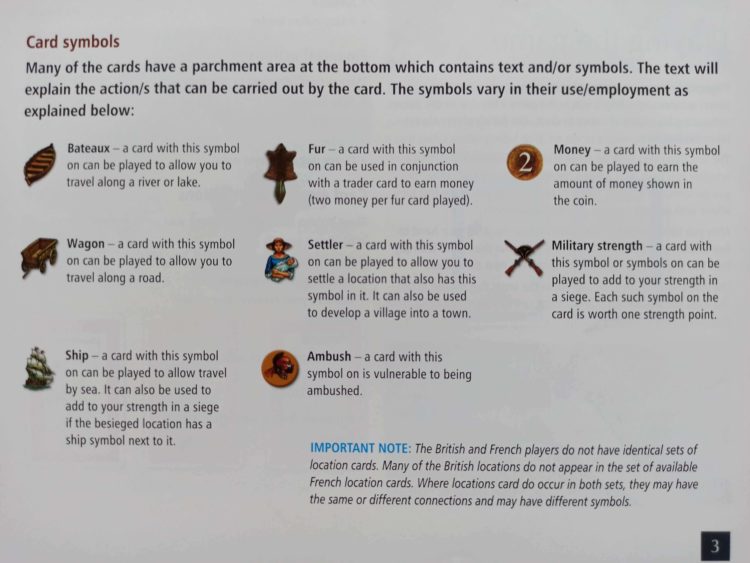
As well as the two types of cards in the game:
The Location cards (see the card on the left in the example above) represent the locations you control, and are starting points from which you can colonize other locations. The Quebec location card provides a lot of information:
- to the right of the Boat symbol: the locations you can reach from this location via rivers or lakes.
- to the right of the Ship symbol: the locations you can reach from this location via the sea.
1. Expansion Actions
1.1. Colonizing an unoccupied location
Requirements: card of a controlled location linked to the location to be colonized + card with the required transport symbol (+ card with the settler symbol if necessary).
Action:
- discard the required cards
- place a cube on the colonized location
- place the location card on your discard pile
Example:
The British player wishes to colonize Deerfield. To do so, he must:
- play a starting point card (New Haven, connected to Deerfield by a river)
- play a means of transportation card, in this case with the boat symbol (St. Mary’s)
- play a card with the settlers symbol because the Deerfield square has this symbol (Philadelphia).
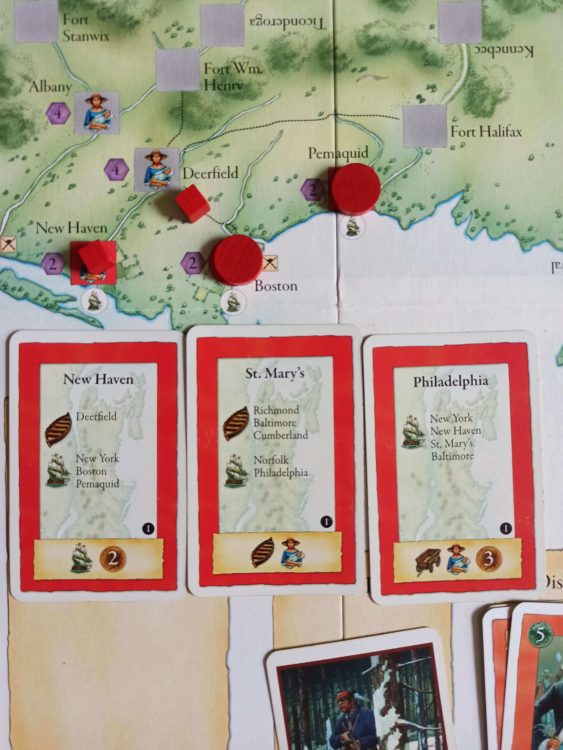
Once that’s done:
- he places a red cube on Deerfield
- he takes the Deerfield card from the pile of British Location cards
- he puts it on top of his discard
1.2. Developing a location
This action consists in improving one of your villages (cube) to transform it into a city (disk).
Requirements: Card of the location to develop + card with a settler symbol.
Action: Replace the cube with a disc.
Limitations:
- You can only develop locations that score victory points (purple hex next to the location on the board).
- you cannot develop more locations than the number of your colour discs available.
1.3. Fortifying a location
Requirements: card of the location concerned + Fortification card + 3 coins.
Action: Place a Fortification disc on the location, under the cube or coloured disc.
Advantages: The fortification protects the linker from raids and adds 2 to his defence in case of siege.
Limitations: You can fortify a location only once.
2. Offensive Actions
2.1. Besiege a location
Attacking an opponent is performed almost the same way as colonization, the difference being that instead of settlers, soldiers are brought in, represented by the military symbol.
Requirements: card of a controlled location connected to the target location + card with the required transport symbol + military force symbol card (can be a ship symbol if the attacked location has a ship symbol).
Action:
- The first two cards are discarded.
- The third card (military force) is placed on the player’s siege space (British Siege or French Siege).
- Then take your Besieged Location marker (cylinder of your colour) and place it in front of the location you are besieging.
- Position the Siege Strength marker on the corresponding Siege Track (British Siege Track for a siege initiated by the British player) taking into account the initial Siege Strengths of both sides:
- Defender’s Military Strength: Place the Siege Strength marker on the underlined 1 value space (each location has an initial defensive strength of 1). If the location under attack has been fortified, move the marker an additional two spaces. If the location has additional fortifications (military symbol next to the location on the board), move the marker accordingly.
- Attacker’s military strength: Move the marker in favour of the attacker by a number of spaces equal to the military strength of the 3rd card played.
The siege has now begun and will last until one player wins or the besieging player retreats.
Note: you may only besiege ONE location at a time, although you may also be involved as a defender in another siege.
Example:
The British player lays siege on Louisbourg.
He plays the Halifax card (the location he controls, which connects Louisbourg by sea), then a card with a ship symbol, and finally a Siege Artillery card (which costs 3 coins to play). He places his Besieged Location marker in front of Louisbourg. His first two played cards are discarded, his Siege Artillery card is placed on his “British Siege” space.
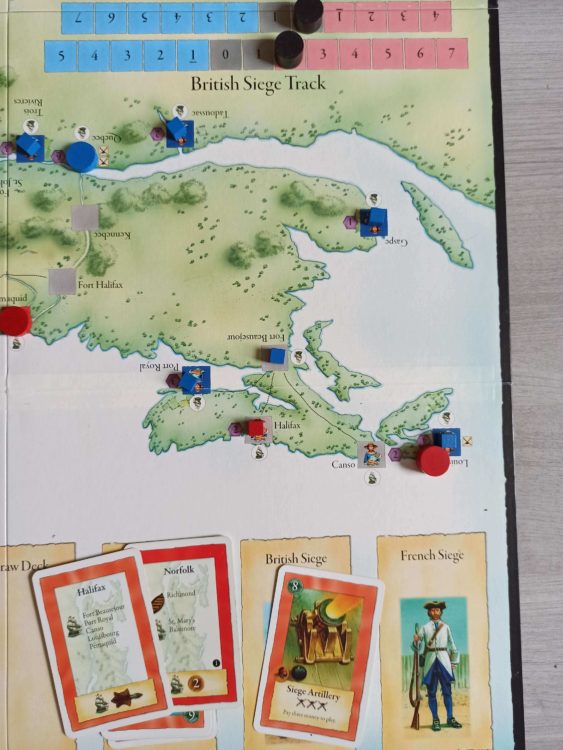
In addition to having an initial defence of 1, Louisbourg also has one defence symbol (indicated on the board). The Siege Strength marker is therefore placed on the 2 (1 + 1) box in favour of France.
Then the British player moves the Siege Strength marker 3 spaces in his favour, corresponding to the military strength points on his Siege Artillery card.
As a second action, the British player plays a Regular Infantry card, as well as a Military Leader card (free action). He therefore moves the Siege Strength marker another 3 spaces in his favour, and places both played cards on his “British Siege” space.
2.2. Reinforcing a siege
Requirements: Any card with a military symbol.
A ship symbol counts as 1 strength point if the besieged location can be reached by sea.
Siege artillery costs an additional 3 when played.
Action: The card must be placed on your corresponding “Siege” space.
Note: playing the Military Leader card is a free action.
Example: It is now the turn of the French player, who chooses to fight back. He plays two siege reinforcement actions: a Regular Infantry card and the Port Royal card, which has a ship symbol. Since Louisbourg has a ship symbol, it is accessible by sea and can therefore receive help from warships (for a military strength of 1 per ship). The French player therefore moves the Siege Strength marker 3 spaces in his favour, and places both cards on the “British Siege” space on his side of the board.
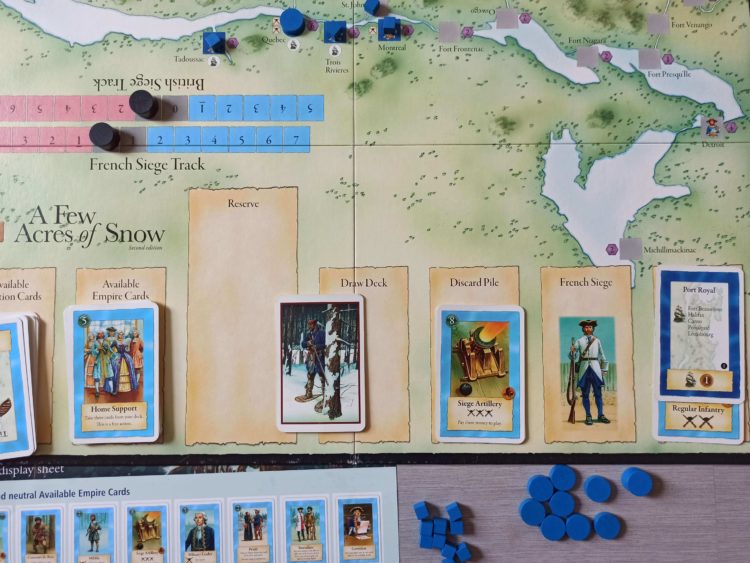
| Checking the sieges: At the beginning of your turn and before any other action, you have to verify the siege tracks to see if you’ve won a siege.If you are an attacker and the Siege Strength marker indicates a strength of 2 or more in your favour, you win the siege immediately:remove and keep the opposing cube / disc from the conquered locationalso remove the Fortification disc if there is one, and put it back in the storage near the board.you can immediately colonize the conquered location (does not count as an action)if the conquered location has a settler symbol, you must play a card from your hand with a settler symbol to colonize the location.otherwise you can place one of your village cubes directly on it.if you choose to colonize the conquered location, then take the corresponding location card from your “Available Location Cards” pile and place it in your discard pile.If you are the defender and the Siege Strength marker indicates a strength of 1 or more in your favour, you win the siege immediately, and retain control of the location. Note: the player who has lost the location still retains the corresponding location card, but can no longer use it, which will penalize his pace of play. When a siege attack has been resolved, both players retrieve their cards from the corresponding “British/French Siege” spaces:the winner places all his cards on his discard pile.the loser must put one of his cards of his choice back into his “Available Empire Cards” pile or the neutral empire card pile, then discard the other cards (he cannot choose to lose a location card under any circumstances)The French player may choose the Infantry card from his initial draw pile.if the loser is not able to select an empire card to remove, he does not remove a card.the attacker retrieves his Besieged Location marker. |
2.3. Raid
You can launch a raid on a location connected to a location that you control by rivers, lakes, roads or Indian tracks (dotted line on the board).
Requirements: a number of cards with the Raid ability corresponding to the distance to the target location.
- the first card played allows you to launch a raid on a location located two connections away from a location you control.
- each additional card played increases the raid distance of one connection
- a Priest or Indian Chief card increases the range of the raid, but cannot be used alone to launch a raid.
- you must pay 1 coin for each Native Americans card you play, not just the first one.
- you cannot launch a raid on a location that has a fortification disc.
Action:
- the opponent can block your raid, either by discarding a Block raid card or the location card of the raided location.
- if the raid succeeds, you capture the opposing cube / disc from the location. The owner replaces a captured disc with a cube. If you have taken a cube, it means that the opponent has lost control of the location, which becomes neutral again.
2.4. Ambush
Play an Ambush card to eliminate an enemy card. Your opponent can block your ambush by discarding a Block ambush card.
- if the ambush is successful, the opponent must place a card with the ambush symbol (Indian head) from his hand or reserve back into his “Available Empire Cards” pile.
- if he doesn’t have any card with the ambush symbol, he has to show you the cards in his hand to prove it.
2.5. Priest / Indian Chief cards
Your opponent must give you a neutral Native American card from his hand or reserve.
- If he doesn’t have such card, he has to prove it by showing you the cards in his hand.
- place the Native American card you obtained in your discard pile.
3. Financial Actions
3.1. Making money
Play one (and only one) location card to take the amount of money indicated on it.
3.2. Merchant
Play a card with a ship symbol, then any number of cards with a money symbol, and take the amount of money corresponding to the cards played (except the card played for its ship symbol)
3.3. Dealer
Play the Dealer card and any number of cards with a fur symbol. Earn 2 money for each card played.
3.4. Piracy
French player only. Play the Louisbourg card with another card that has a ship symbol to steal 2 coins from the British player. If he does not have enough money, take the missing money from the bank.
4. Empire Management Actions
4.1. Taking a new Empire card
Take one empire card (either from your “Available Empire Cards” pile or from the Neutral Empires card pile. Pay the bank the cost, if any, of that card (shown in the top left corner).
Place the card on your discard pile.
4.2. Discarding cards
Pick and discard one or more cards from your hand. The first card discarded costs nothing, each additional card costs 1 coin.
4.3. Placing a card in reserve
Pick a card from your hand and place it in your Reserve space on the board. You can place as many cards in your reserve as you want, but each card placed costs one action.
4.4. Recovering the reserve
Take all the cards from your reserve and put them back in your hand.
- You have to pay 1 coin for each card recovered. If you cannot pay the full cost, you cannot perform this action.
- Free action (does not count in the two actions per round)
4.5. Governor card
Choose one or two cards from your hand and place them back in the corresponding “Available Location/Empire Cards” piles.
4.6. Intendant card
French player only. Pay 2 coins to look for a card of your choice in your discard pile, then put it in your hand.
4.7. Home Support card
Free action. Draw three cards from your deck.
5. Other Actions
Withdraw from a siege
- free action
- resolve this action as if you had lost the siege
Pass
- do nothing
END OF GAME
The game ends if ONE of the 3 conditions is met:
- Win by Siege (instant win): the game ends immediately if
- the British player manages to capture Quebec City (British victory)
- the French player manages to capture New York or Boston (French victory)
- Emptying the stock of cubes or discs: If a player has placed all of his discs OR all of his cubes (and there are no sieges at the beginning of the round), the points must be counted to identify the winner.
- Capturing 12 points: if a player has captured cubes and/or discs from his opponent for a total of 12 points (and there is no siege in progress), the points must be counted to identify the winner.
Score
Players add up their victory points:
- Controlled locations: Score victory points for locations you control (where you have a cube or disc). A disc doubles the victory points reported by a location.
- Captures: 2 victory points per cube captured from your opponent, and 4 points per disc.
The player with the most victory points wins (in case of a tie, the French wins).
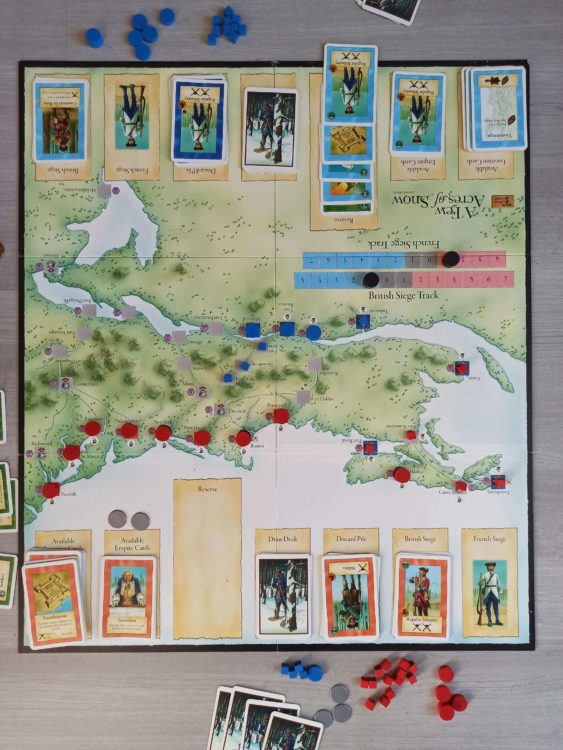
- Comprehensive Guide to the Board Game Go (weiqi, baduk) - January 23, 2024
- Are Creative Suites Changing Gaming - October 30, 2023
- How Classic Games Have Been Reimagined for Modern Audiences - October 5, 2023